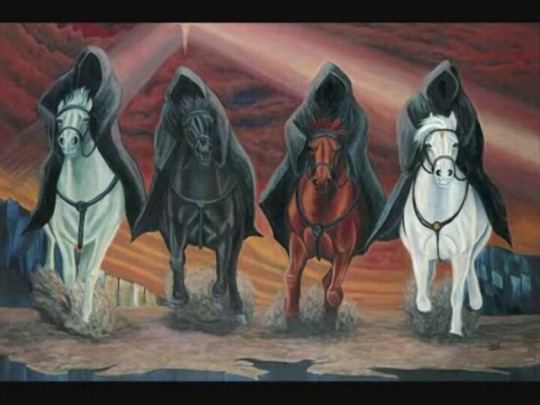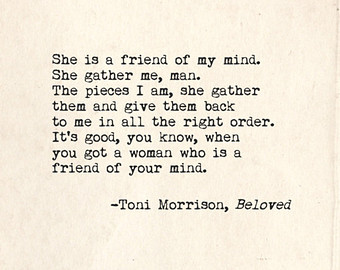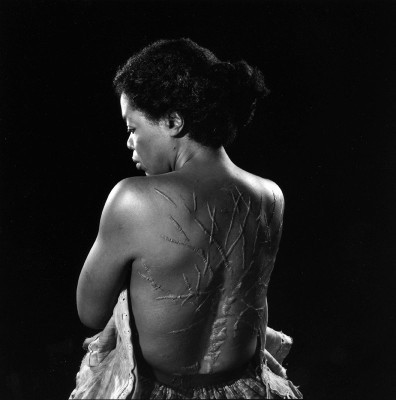Text
Biblical Allusions
In Beloved, there are numerous references and allusions to aspects of the bible and Christianity in general. The address of the house, 124, is one of them as well as the four horsemen; school teacher, his nephew, the sheriff, and the slave hunter. These are just a few, but the inclusion of these many illusions play an important role in the plot of the novel as a whole.
The four horsemen represent the haunting effect slavery has and continues to have on Sethe and her family. Even after a considerable amount of time has passed since Sethe was in slavery, the four horsemen come back during the slaughtering of Beloved to remind her of her passed. This apocalyptic reference is the backbone of salvery’s reoccurring visits in Sethe’s life.
The fact that the appearance of the four horsemen triggered Sethe into the the slaughtering of Beloved and the potential death of her other children also alludes to the apocalyptic element of the story; their arrival brings about death which then follows the relief from slavery. This was the mindset that many slaves had during this time. Death would be better than slavery.
0 notes
Text
February 28th: Motif
There are many motifs that play an important role in Beloved and reveal multiple ideas as well as perspectives to the story. One that has a distinctive impression on the audience are the allusions to Christianity; specifically, when Sethe has Denver drink her milk while covered in Beloved’s blood and the coming of the four horsemen. Although there are numerous allusions to Christianity, these seem to stand out more prominently than the others.
After slaughtering baby Beloved, Sethe proceeds to breastfeed Denver whilst covered in the blood of her deceased baby. As a result, she drinks the blood of Beloved along with Sethe’s milk. This is symbolic of communion, as Denver drinks the blood of the sacrificed (Beloved).
The four horseman appear in Beloved as schoolteacher, schoolteacher’s nephew, the slave hunter, and the sheriff. They represent an apocalyptic aspect and reveal the detachment and inhumanness that the white men had for black slaves. They also bring with them the grueling and difficult future that lies ahead for Sethe.
0 notes
Text
February 22nd: Symbol
Although there are many instances of symbolism in “Beloved”, one of the most prominent is the symbol of rebirth in the form of water. Beloved is introduced in the novel when she emerges out from the water and finds herself at 124. This is an excellent example of rebirth because after she comes from beneath the water, Beloved is immediately taken in to where she was supposed to be this entire time; alive with Sethe. Even more proof of this symbol is in this quote: “But there was no stopping water breaking from a breaking womb and there was no stopping now.” (Ch. 5 Line 5)
Another example of symbolism in “Beloved” is Paul D’s tobacco tin box which time has taken its toll on and rusted over. This box is a symbol for Paul D himself, as it has a hard and cold exterior. Paul D is distant and emotionally unavailable when it comes to intimate relationships with women, and the box represents these characteristics in a physical form. For Paul D, the box constitutes a sense of privacy and seclusion. Similar to how he felt in the box when he was in the chain gang, the box mirrors the coffin he was kept in in the sense that it couldn’t be easily opened. When the narrator says, “He would keep the rest where it belonged: in that tobacco tin buried in his chest where a red heart used to be. Its lid rusted shut.” (Ch. 7), this implies that the tin is not only a symbol of privacy, but also a replacement for his heart. His heart is closed shut tightly, just like the tin.
Trees also serve an important purpose in “Beloved”, as they symbolize concealment and protection. A very noticeable instance of this symbol is the ‘chokecherry tree’ on Sethe’s back. Although this is a large scar made from a brutal beating and trauma, Sethe covers up the scar’s past by implying that it grows and is beautiful. An example of this is when she says, “Trunk, branches, and even leaves. Tiny little chokecherry leaves. But that was eighteen years ago. Could have cherries too now for all I know." (Ch. 1) The implication of the growth of fruit from the scars on her back show that she see’s the wound as something positive and ever-changing.
0 notes


